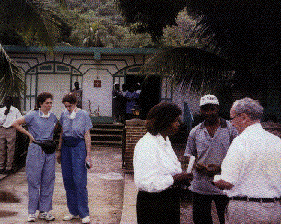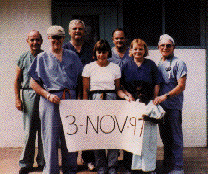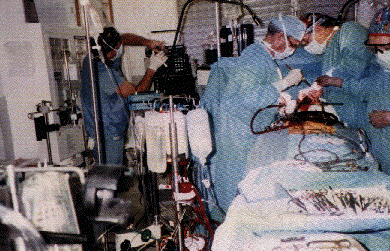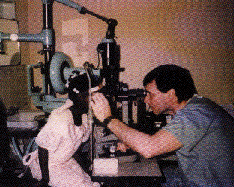|
|
|||
|
|
|
||
|
|
|||
|
|
|||
|
|
|||
|
|
|
||
|
(Based on the Rivista Internazionale) CRUDEM Project by T.J. Dubuqze, Jr. President of the CRUDEM Foundation. |
|
This is a brief history of the CRUDEM Project, a mission in Milot, northern Haiti. CRUDEM began in 1968 when the people of Milot went to the brothers of the Sacred Heart and asked for help in improving conditions in their village. Brother Yves Beausejour, s.c., then aged 34 with already ten years of service in Haiti, was sent as director along with two other brothers. They named the project CRUDEM (Center for the Rural Develpment of Milot). Milot and the neighbouring centers have a population of 25,000. There are twelve miles from Cap-Haitien, the second largest city in Haiti. Milot was the capital of Haiti shortly after it gained independence in the earls nineteenth century and the remnants of the palace are still visible there. A fortress, the Citadel, was built at the same time to defend against the return of French troups. It has been restored and can be seen on the mountain top above Milot. |
| Haiti is the poorest country in the Western Hemisphere with a per capita annual income of about $350. It also has the highest maternal and infant mortality, and almost 10% of children die before age two. No people have access to electricity or potable water and less then half can read. |
|
Brother Yves enlisted the help of the local population and rapidly went to work. He brought electricity to Milot by installing a hydroelectric generator at a large spring in the mountains. The water was piped out into the village, giving them clean water for the first time. He built 75km of roads and constructed bridges over streams previously impassable after rains. He built eleven primary schools, a technical high-school, and a teachers' junior college. Four dispensaries were provided, one in Milot and the others in surrounding communities. Cooperatives were established with various local groups to raise pigs, chickens, dairy cattle and produce chocolate and bakery goods. |
|
In 1983 a young Haitian internist, Dr. Herve Thelusmond, came to work at the dispensary in Milot. All the dispensaries had previously been staffed by nurses. The Milot dispensary become a referral center and it soon became obvious that a larger facility was needed. A hospital was completed in early 1986, containing twenty beds, a pharmacy, laboratory, x-rays, delivery and operating rooms. A Nutrition Center was built adjacent to the hospital. 
|
| The hospital had an operating roon but no surgeon or surgical equipment. Brother Yves and Dr. Thelusmond contacted the Catholic Medical Mission Board in New York seeking a volunteer surgeon. I was also in touch with the Mission Board then and learned of CRUDEM. I made a brief visit, liked what I saw and agreed to return for six months beginning in October 1986. |
|
Funds from family and Annunziata Church in St. Louis were obtained to equip the operating room and the first operation was done on November 17, 1986. Soon after, Carlos Reese of St. Louis became interested in CRUDEM and has been active in fund raising. More recently Tom O'Toole has joined him. A Haitian surgeon replaced me when I returned to the USA. The hospital now has a permanent staff of six physicians and employs fifty people. Dr. Thelusmond's wife, Annie, is the hospital administrator and the liaison between the hospital and its volunteers and supporters in the United States and Canada. 
|
|
The idea of helping the sick and the poor in a mission hospital is one that has great appeal to doctors and nurses. After my return, others began asking about the possibility of helping Milot. The second volunteer went for a three week visit in February 1988 and soon others followed. By July 1995, 125 volunteers have been to CRUDEM, many of them more then once. Special teams go on a regular basis, providing expert care otherwise available only in private hospitals in Port-au-Prince. 
|
| Despite the oppressive poverty and political problems in Haiti the people are invariably clean, polite and very grateful for what is done for them. The usual comment by returning volunteers is that they have never done anything so rewarding. |
| Since there are no newspapers or television and few radios in the area, word is sent out through churches on Sunday when a visiting special team is to arrive. The news travels quickly. It is not unusual for patients to come from as far away as the capital Port-au-Prince, a full day's bus ride away. |
|
Malaria and tuberculosis are still common in Haiti. Surgical problems have often been present for a long time when the patient first comes to CRUDEM. For example, cataracts are so common that they are not removed until the patient is totally blind. In 1995 over 15,000 patients were seen at the hospital. The average daily census of inpatients is 20, with as many as 30 when a visiting surgical team is present. 
|
| The Nutrition Center serves two free meals daily to over 100 malnourished pre-schoolers. An educational program is provided for the children between their two meals. Another 500 primary schools students receive their education under CRUDEM auspices. |
| With the increasing activity, financial responsibility for CRUDEM was divided in 1989. Development projects are funded by Canada and the hospital complex and educational programs are supported by the CRUDEM Foundation in St. Louis. Nominal charges are made to the patients, otherwise they tend to feel the treatment or medicine is worthless, but no patient is refused because of inability to pay. |
|
In September 1994 CRUDEM received a large Child Survival Program grant from the United States Agency for International Development and Project HOPE. The Program is designed to reduce the high infant and maternal mortality in Haiti by a combination of outreach education and medical care. It affects a population of 70,000 and has made CRUDEM a major factor in health care in Haiti. The CRUDEM Foundation is a tax exempt public charity whose purpose is to support Project CRUDEM. CRUDEM has no administrative expenses thank to the help provided by Annunziata Church in St. Louis. No volunteer has been paid to go to CRUDEM and physicians usually pay their own travel expenses. The American Association of the SMOM actively support CRUDEM as does Project HOPE, who are not only our partners in the Child Survival Program but were also donors of almost $2 millionworth of medicine in November 1994 to CRUDEM and other health care facilities in northern Haiti. The Koch Foundation, Direct Relief International, Medisend, Collaboration Sante Internationale and Holy Cross Hospital in Fort Lauderdale have also been very helpful. Many of our volunteers have beene referred by the Catholic Medical Mission Board. Individual donors are too numerous to mention, suffice to say we have been most fortunate in having such loyal and generous benefactors. It is estimated that the value of each dollar received is multiplied ten times because of the value of the care donated by volunteers and gifts of medicine, supplies and equipment. In 1986, when CRUDEM began, Brother Yves designed the logo printed on the top left of the first page - a rooster crowing "Wake up Milot". The entire CRUDEM family sends you thanfs for your support and encouragement in the awakening. |